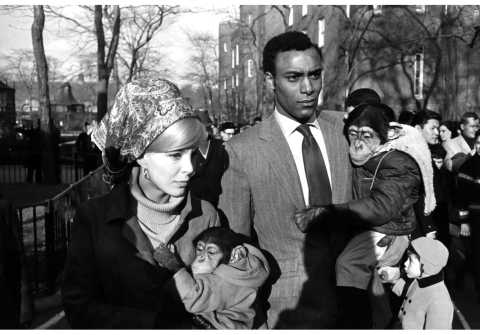As you know, my argument is that we’re in another economic depression now, and my day in New York made the comparisons to the 1930s striking.
I started at the Met, where I finally got to see America Today, the murals by Thomas Hart Benton that have been re-homed from the New School. Over the years there, students had rammed chairs into the murals, and they were otherwise degrading. Now revitalized in glorious color, made richer through the darkened exhibition space, the murals tell the story of America in a moment–1930-1, when the Great Depression was just sucking away the country’s vitality.
Benton celebrates though. America’s pulse, its chaos and determination, its strengths and its smarts.
Certainly compared with Reginald Marsh’s nearby The Bowery from the same year, 1930, the murals are propagandistically optimistic. The glory of work, the ingenuity of technology, the voice of entertainment, all punctuated with clarifying red.
Benton loved red.
While the curators draw connection to Baroque painting as an influence on Benton’s energetic compositions, I was also taken by the drama of the Renaissance tapestries, a newly opened, scintillating exhibition at the Met. Surely Benton was influenced by the Renaissance body and borrowed from religious ecstasy for his modern passions.
And where would Jackson Pollack be if he hadn’t been under the influence of his teacher’s, Benton’s, quivering, pulsating storytelling? And Benton was completely modern, as you can see here.
But the art historian digresses.
Back on point, we, too, today crave celebrity entertainment and the refuge of technological wizardry to forget our troubles with work and the sour economy. We like to think of America’s strength, even as evidence shows the contrary.
From the Met, I walked over to the newly-open-for-tours Roosevelt House. After Sara Roosevelt’s death, in 1942, Hunter College bought the house and has been using it for classrooms. Just about the only thing left from the quiet wealth of the Roosevelts is the staircase bannister. I ran my hand up the rail where Eleanor may have, too. I haven’t washed my hand since!
I joined a tour/lecture, led by a history doctoral student. As he told us about FDR’s and Eleanor’s accomplishments, I was most taken by the Four Freedoms speech, so relevant today. Only the names have changed. Have we progressed at all?
I was interested in the speech’s afterlife. Norman Rockwell had a hard time getting support to make his monumental paintings of the same name. Finally, the Saturday Evening Post printed the series, which became phenomenally popular, driven by a Bentonesque vision of America. Then the war bonds office came up with a program. For an $18.75 war bond purchase, you would receive a set of the four posters. And the rest is history.
Or is it? How much do we tolerate freedom of religion post 9/11? In light of a string of natural disasters and Ebola, how free from fear are we? In an era of political correctness, changing mores, and lax gun laws, are we really free to speak our minds?
 And freedom from want? That issue was actually secondary in “Grand Concourse,” now at Playwrights. Yes, it takes place in the Bronx today in a soup kitchen. Yes, one of the four characters is a homeless man who teeters on the ability to get and hold a job and function well, but I think playwright Heidi Schrek uses her setting as a metaphor, a rumination on the nature of giving and how generosity of spirit can get twisted. People younger than I am, though, may see the play through different eyes. Check it out, and see what you think.
And freedom from want? That issue was actually secondary in “Grand Concourse,” now at Playwrights. Yes, it takes place in the Bronx today in a soup kitchen. Yes, one of the four characters is a homeless man who teeters on the ability to get and hold a job and function well, but I think playwright Heidi Schrek uses her setting as a metaphor, a rumination on the nature of giving and how generosity of spirit can get twisted. People younger than I am, though, may see the play through different eyes. Check it out, and see what you think.
Regardless, may you be free from want this harvest season, on all levels of body and being.





























